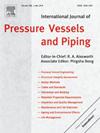A new method for predicting residual stress in light alloys using truncated conical indentation
IF 3
2区 工程技术
Q2 ENGINEERING, MECHANICAL
International Journal of Pressure Vessels and Piping
Pub Date : 2024-12-30
DOI:10.1016/j.ijpvp.2024.105427
引用次数: 0
Abstract
A new method was proposed for predicting residual stress in light alloys using truncated conical indentation. In this method, a truncated conical indenter with a cone angle of 120°, insensitive to edge-chamfer and friction effects, was used to test the residual stress of light alloys. Selecting the ratio of indentation work between stressed and unstressed specimens as an analytical parameter, a dimensionless truncated conical indentation (TCI) model related to the ratio of indentation work between stressed and unstressed, material properties, and normalized residual stress was established via dimensional analysis and numerical calculations. The TCI model could predict equi-biaxial residual stress and uniaxial residual stress, and its accuracy was verified in a wide range of light alloys with varying residual stress by numerical simulation. The stability of the TCI model is verified numerically by introducing errors in material parameters. Truncated conical indentation tests were conducted on cruciform specimens and rectangular specimens respectively made of three aluminum alloys. The results exhibited the residual stress predicted by proposed method agrees well with the applied stress, and the relative errors between them were within ±10 % in most cases.
求助全文
约1分钟内获得全文
求助全文
来源期刊
CiteScore
5.30
自引率
13.30%
发文量
208
审稿时长
17 months
期刊介绍:
Pressure vessel engineering technology is of importance in many branches of industry. This journal publishes the latest research results and related information on all its associated aspects, with particular emphasis on the structural integrity assessment, maintenance and life extension of pressurised process engineering plants.
The anticipated coverage of the International Journal of Pressure Vessels and Piping ranges from simple mass-produced pressure vessels to large custom-built vessels and tanks. Pressure vessels technology is a developing field, and contributions on the following topics will therefore be welcome:
• Pressure vessel engineering
• Structural integrity assessment
• Design methods
• Codes and standards
• Fabrication and welding
• Materials properties requirements
• Inspection and quality management
• Maintenance and life extension
• Ageing and environmental effects
• Life management
Of particular importance are papers covering aspects of significant practical application which could lead to major improvements in economy, reliability and useful life. While most accepted papers represent the results of original applied research, critical reviews of topical interest by world-leading experts will also appear from time to time.
International Journal of Pressure Vessels and Piping is indispensable reading for engineering professionals involved in the energy, petrochemicals, process plant, transport, aerospace and related industries; for manufacturers of pressure vessels and ancillary equipment; and for academics pursuing research in these areas.

 求助内容:
求助内容: 应助结果提醒方式:
应助结果提醒方式:


